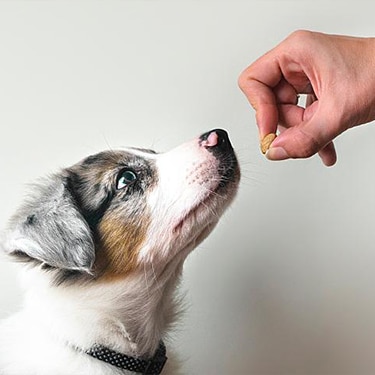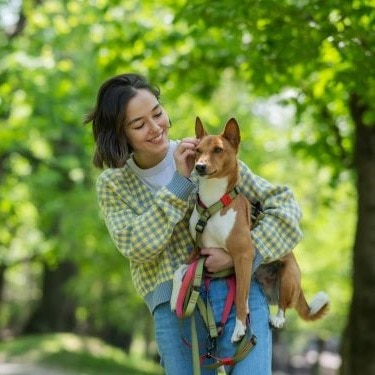
-
Find the right food for your petTake this quiz to see which food may be the best for your furry friend.Find the right food for your petTake this quiz to see which food may be the best for your furry friend.Featured products
 Puppy Chicken & Rice Stew
Puppy Chicken & Rice StewChicken & Rice Stew with great taste and precisely balanced nutrition to support 5 essential building blocks for lifelong health
Shop Now Adult No Corn, Wheat, Soy Savory Stew with Chicken & Zucchini Dog FoodShop Now
Adult No Corn, Wheat, Soy Savory Stew with Chicken & Zucchini Dog FoodShop Now Adult Perfect Weight & Joint Support Hearty Vegetables and Tuna Stew Dog FoodShop NowFeatured products
Adult Perfect Weight & Joint Support Hearty Vegetables and Tuna Stew Dog FoodShop NowFeatured products Adult Urinary Hairball Control
Adult Urinary Hairball ControlSupports the health of the whole urinary system with optimal levels of magnesium
Shop Now Adult Chicken Recipe Cat Food
Adult Chicken Recipe Cat FoodSupports lean muscle and beautiful fur for adult cats
Shop Now Sensitive Stomach & Skin Chicken & Vegetable Entrée Cat Food
Sensitive Stomach & Skin Chicken & Vegetable Entrée Cat FoodHill's Science Diet Adult Sensitive Stomach & Skin Chicken & Vegetable Entrée canned cat food provides nutrition for optimal digestive & skin health.
Shop Now -
Dog
- Dog Tips & Articles
-
Health Category
- Weight
- Food & Environmental Sensitivities
- Urinary
- Digestive
- Joint
- Kidney
-
Life Stage
- Puppy Nutrition
- Adult Nutrition
- Senior Nutrition
Cat- Cat Tips & Articles
-
Health Category
- Weight
- Skin & Food Sensitivities
- Urinary
- Digestive
- Kidney
-
Life Stage
- Kitten Nutrition
- Adult Nutrition
Featured articles The Science Behind Our Love for Pets
The Science Behind Our Love for PetsLearn the scientific reasons why we have such strong connections with our pets, and what science says about the love between humans and our furry friends.
Read More What Is Littermate Syndrome? Pet Adoption Guide
What Is Littermate Syndrome? Pet Adoption GuideLearn more about littermate syndrome in dogs and cats and how to successfully navigate adoption and early socialization processes.
Read More How to Properly Mix Wet & Dry Pet Foods
How to Properly Mix Wet & Dry Pet FoodsAn Orange cat eating from a bowl filled with mixed food
Read More -


Leptospirosis (also commonly known as lepto) is a contagious disease that all mammals may acquire at some point. Leptospirosis in dogs is caused by Leptospira bacteria. Though the disease occurs all over the world, it's more common in warm, wet climates and during rainy seasons.
In the past, hunting dogs and dogs who spent a lot of time in wild areas were at the highest risk for the disease. Now, leptospirosis is more commonly seen in urban dogs who have been exposed to the disease from mammals that live in cities, like squirrels, raccoons, skunks, moles, shrews, opossums, deer and rodents. Small breed dogs who live in urban areas and who are unvaccinated are at the highest risk for lepto.
Let's take a closer look at how this disease is spread, the clinical signs that a dog has leptospirosis and what you can do to help prevent your dog from contracting this disease.
How Is Leptospirosis in Dogs Spread?
Lepto is spread in one of two ways: by direct transmission or by indirect exposure via an environment that's contaminated with urine from an infected animal.

Leptospira bacteria get in through mucus membranes (the oral cavity, for example) or through damaged skin. Direct transmission can occur if a dog comes into contact with urine, placenta, milk or semen from an infected animal. Indirect exposure occurs when a dog comes into contact with Leptospira bacteria via a contaminated environment, either soil, food, water, bedding or vegetation. Leptospira can only survive in a warm and moist environment, and they're often found in marshy, muddy or irrigated areas where the temperature is between 45 and 96 degrees Fahrenheit (36 °C) . The bacteria can survive up to 180 days in wet soil and even longer in standing water. Freezing temperatures, dehydration or direct sunlight can kill Leptospira.
Dense animal populations, such as shelters, kennels and urban areas, are at an increased risk of lepto. The disease can be transmitted from dogs to humans, but the risk of this happening is low. Veterinarians, veterinary staff, dairy workers and livestock producers are at an increased risk for contracting lepto. It's also important to note that exposure to stagnant water also presents a risk.
Clinical Signs of Leptospirosis in Dogs
Many dogs who are infected with lepto don't show any signs at all. Whether they become ill depends on their immune systems and which species of Leptospira bacteria they're exposed to. Not all species of Leptospira cause the disease, and over 250 species have been classified worldwide. The two most commonly affected organ systems by Leptospirosis are the liver and kidneys. In Europe, certain species of Leptospira bacteria can cause severe damage to the lungs, but thankfully, these species of leptospira have not been documented in the United States.
If a dog is going to get sick, it will happen after the incubation period, which can last from four to 20 days. Acute disease happens after the incubation period and while symptoms will vary largely by what organ systems are more severely affected, general symptoms can include fever, general soreness, fatigue, and weakness. Additional clinical signs associated with the acute form of the disease include:
- Vomiting
- Loss of appetite
- Jaundice (yellowing of the eyes, skin and gums)
- Difficulty breathing
- Drinking and peeing a lot
- Diarrhea
- Elevated heart rate
- Red eyes
- Runny nose
In severe cases, leptospirosis may result in liver or kidney failure. Animals may also become infected with chronic forms of the disease, resulting in long term damage the liver and kidneys.


Tasty Tips

Diagnosing and Treating Leptospirosis in Dogs
A vet will review your dog's oral history, vaccination history, physical exam findings and laboratory tests to diagnose lepto. Your vet may order diagnostic tests, including bloodwork, urinalysis, imaging studies such as an abdominal ultrasound or radiology, and specific tests for lepto. Tests for lepto vary and are focused on either detecting antibodies against lepto in the bloodstream or detecting leptospira bacteria itself in body tissues or fluids. Antibody tests will likely need to be repeated in three to four weeks to check for rising antibody titers, which helps diagnose infection.
When dogs infected with leptospirosis are hospitalized, they are usually kept in a special isolation ward to prevent the spread of the disease to other dogs in the hospital. They're treated by veterinary staff wearing PPE (gloves, gowns and face shields) to prevent accidental contact of mucus membranes with infected urine.
Treatment consists of intravenous fluids to correct dehydration and support internal organs, and antibiotics. If a dog has severe liver or kidney failure, additional treatments to address these conditions may be needed.
Preventing Leptospirosis in Dogs
Limit your dog's access to places where Leptospira like to hide, such as marshy and muddy areas, ponds, heavily irrigated pastures and low-lying areas with stagnant surface water.
It can be difficult to avoid exposure to wildlife, like raccoons and rodents, in both urban and rural areas. If you live in an area with leptospirosis, some of which are highlighted in a study in The Veterinary Journal, getting your dog vaccinated is recommended to protect against the disease. Immunity to lepto tends to be species-specific; therefore, vaccines include the specific species of Leptospira seen in an area. If you're traveling, ask your vet if your lepto vaccine protects your dog in other geographical areas. The vaccine doesn't prevent infection; rather, it reduces the clinical signs of lepto. The vaccine requires two boosters at the beginning of the vaccine series, and then yearly boosters are recommended for most dogs thereafter. If your dog hunts, goes to dog shows or has access to water or ponds, be sure to have your dog vaccinated every six months as immunity wanes over time.


Dr. Sarah Wooten graduated from UC Davis School of Veterinary Medicine in 2002. A member of the American Society of Veterinary Journalists, Dr. Wooten divides her professional time between small animal practice in Greeley, Colorado, public speaking on associate issues, leadership, and client communication, and writing. She enjoys camping with her family, skiing, SCUBA, and participating in triathlons.
Related products

Supports healthy joints, lean muscle, and beautiful coat for large breed dogs

Chicken & Barley Entrée in a delicious loaf with great taste and precisely balanced nutrition to support 5 essential building blocks for lifelong health

Chicken & Beef Entrée in a delicious loaf with complete & balanced nutrition to help keep adult dogs active and healthy

Supports lean muscle and beautiful coat for adult dogs
Related articles

Learn how to help keep your dog's immune system in tip-top shape, including nutritional immune system support for dogs and other strategies.

Can puppies have treats? Explore best practices for giving your puppy treats to ensure you're doing so in the healthiest way possible.

Discover how the field of dog science is giving us more and more insights into the inner workings of our furry best friends.

Wondering where can I buy a dog? Consider adoption and explore the pros and cons of adopting a dog from a breeder versus an animal shelter.

Put your dog on a diet without them knowing
Our low calorie formula helps you control your dog's weight. It's packed with high-quality protein for building lean muscles, and made with purposeful ingredients for a flavorful, nutritious meal. Clinically proven antioxidants, Vitamin C+E, help promote a healthy immune system.
Put your dog on a diet without them knowing
Our low calorie formula helps you control your dog's weight. It's packed with high-quality protein for building lean muscles, and made with purposeful ingredients for a flavorful, nutritious meal. Clinically proven antioxidants, Vitamin C+E, help promote a healthy immune system.

